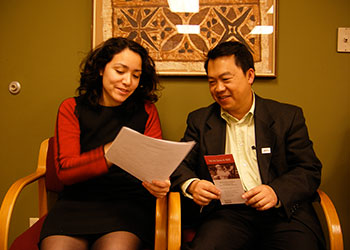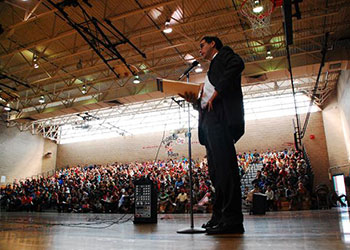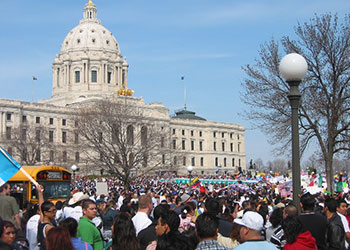News > Immigration In The United States
Proposed HUD Rule Targets Immigrant Families
Posted on Jun 10 2019

As millions of U.S. households struggle to find affordable housing, a newly-proposed HUD regulation would evict more than 100,000 people from public housing. The proposed regulation targets immigrants and would evict families in which even one family member is ineligible for housing assistance.
Currently, these mixed-status families can live together in subsidized housing. Their housing subsidy is decreased so that the ineligible person does not receive assistance. “Ineligible” does not mean “undocumented.” Immigrants can have legal status and still not be eligible for public housing and Section 8 programs. The new regulation, however, would bar all members of mixed-status families from public housing and Section 8 programs.
YOU CAN MAKE A DIFFERENCE: Go to www.Keep-Families-Together.org and submit your comment now! Or submit your own comments directly on regulations.gov.
Many Minnesota children and elders in mixed-status families rely on subsidized housing because of the extremely high costs and low availability of affordable housing. In our daily work at the Immigration Law Center of Minnesota, we see the struggles of immigrant families to find affordable housing, especially in the Twin Cities metropolitan area.
The rental vacancy rate in the Twin Cities metro area is consistently below 5 percent. The housing vacancy rate in St. Paul was 3.3 percent in 2017, and Minneapolis was close to that number with a 3.5 percent vacancy rate.
Affordability is an even bigger problem, in the metro area and throughout the state. The average monthly rental in the seven-county metropolitan area exceeds $1,000 and rises every year. In the city of Minneapolis, the average rent rose to $1,279 in 2017, up 17 percent from 2010. In 2017, the average waitlist time for subsidized housing in Minnesota was 22 months.
This proposed rule does not address the undeniable crisis of affordable housing. Instead, it is part of the Trump administration’s war on immigrants. Blaming immigrants will not solve the nation’s affordable housing problem.
HUD’s own data shows that the proposed rule will evict 108,000 people, with three-quarters of these people being family members who are themselves eligible for subsidized housing. Some 55,000 of the people who would be thrown out of their homes by this rule are children who are U.S. citizens or legal permanent residents. The rule would force mixed status families to either break up to allow eligible family members to continue receiving assistance or forgo housing assistance so that the families can stay together.
In Minnesota, almost 140,000 people live in mixed-status families with at least one unauthorized family member. That includes more than 60,000 children living with at least one unauthorized family member. Nationally, about six million U.S. citizen children live in mixed-status families with at least one unauthorized family member.
While it is clear that the proposed rule is a direct attack on immigrants and citizens in mixed-status households, these families are not the only group that will be harmed if the rule is finalized. In addition to attacking mixed status families, the proposed rule creates red tape that threatens housing security for 9.5 million U.S. citizens currently receiving HUD assistance and all future U.S. citizens seeking these benefits.
Currently, to establish eligibility for housing assistance, U.S. citizens need to provide a declaration signed under penalty of perjury of their citizenship or nationality status. The proposed rule would require that these individuals also provide documentary proof, such as a birth certificate, which can be extremely difficult to obtain for certain segments of the population. One survey from 2006 showed that as many as seven percent of citizens did not have citizen documentation readily available. Obtaining such documentation can be particularly difficult for U.S. citizens over the age of 50, citizens of color, citizens with disabilities, and citizens with low incomes.
In addition to the difficulties faced by individuals, this requirement will create an additional layer of bureaucratic requirements, and divert funding that could otherwise be used simply for providing housing.
Even immigrant and mixed-status families in which every member is entitled to the benefits of subsidized housing or public housing would be affected by this rule. Many would leave public housing or fail to claim benefits because of fear that they would be penalized for using housing assistance. This has already happened in the area of public benefits, where a different proposed regulation would penalize some immigrants for using some programs. The Urban Institute found that one in seven adults in immigrant families reported avoiding public benefit programs in 2018—despite the fact that the proposed public benefits regulation has not yet taken effect and might not apply to them even if it is promulgated.
Immigrants are a critical factor in keeping the U.S. economy healthy and growing. Currently, more than 27 million foreign-born workers in the U.S. labor market comprise about 17% of the total U.S. workforce. Immigrants are more concentrated in labor markets that literally feed and house America—immigrants make up 28% of construction trade workers and upwards of 70% of agricultural workers.
Immigrants are an essential part of our health care system, comprising nearly one in five of all health care workers and nearly one in four health care workers in the long-term care sector. Nearly one worker in three at home health agencies is an immigrant, many earning very low incomes while providing essential care. As the elderly population in the United States continues to grow, we will need more health care workers to provide needed care. In all sectors, immigrant workers replace retiring baby boomers and continue to support the Social Security system and Minnesota tax revenues.
The new HUD rule was proposed on May 10, and a 60-day public comment period will end on July 9.
What you can do—make your voice heard!
- The National Housing Law Project (NHLP) and National Low Income Housing Coalition (NLIHC) are leading the effort to oppose this harmful and cruel proposal and have developed advocacy tools for you to use to join us in opposition. Together, NHLP and NLIHC launched a new website for individuals to submit their comments. Go to www.Keep-Families-Together.org and submit your comment now!
- To learn more, check out their fact sheets, talking points, and social media toolkits.
- You can also submit your own comments directly on regulations.gov.




